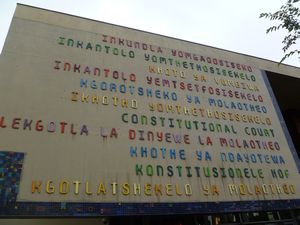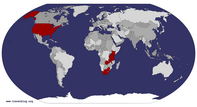Advertisement
Published: March 4th 2012

 1
1
The words 'Constitutional Court' written in all eleven official languages of South Africa.Well, here I am in one of the crime capitals of the world, and I brought with me from Zambia a new stamp in my passport, souvenirs that I didn't really want but felt obliged to buy, and a course of antibiotics for the gastric infection that somewhere, somehow, I managed to pick up. Luckily you can buy antibiotics over the counter here, without a prescription, which saved me a lot of time and hassle.
At this point I'd like to backtrack a little, and apologise to Johannesburg for calling it a crime capital. Because although that's the reputation that it's ended up with, the reality doesn't quite live up to the hype. I was expecting to have to lock the car door whenever we stopped at traffic lights, or be on constant high alert for guns, but there was none of this. As long as you're careful and sensible, and you avoid the places that are particularly renowned for crime, everything should be all right; it's the same for any big city, so I didn't feel any less at ease in Johannesburg as I do when I visit London or other European cities.
I set out today on

 2
2
A leafy side street at the court on Constitution Hill.an 'ultimate tour' of Johannesburg - Jo'burg as it's commonly called, or less commonly but more locally, Jozi. It started with a drive through the city itself, including Hillbrow, where white people just don't go because of the area's reputation for crime. Yes, I did recommend just a few sentences ago that you should avoid such places, but let's just overlook that minor detail and move on. We'll all feel better for it. There are a lot of empty buildings there in Hillbrow; people are driven out of buildings that they own, and the people who take them over leave them empty and dilapidated, and falling apart. The city is trying to fix the problem by using security companies to return the buildings to their rightful owners, but it seems like quite a big task.
My guide took me to Constitution Hill, where there used to be a prison that once held both Nelson Mandela and Gandhi (at different times, of course, before some smart person tries to correct me) as a result of their opposition to separatist laws in South Africa. Although they were given private cells because of their political standing, the prison wards were generally overcrowded

 3
3
Poignant words, some of many, on a message board at the court.and unhygienic, with black men and women being repeatedly arrested for minor offences just because of their skin colour. One of the prison blocks was demolished in 2001 to make way for the building of the new Constitutional Court, and whilst the four staircases of the block were retained as a reminder of what black South Africans had been put through not so long ago, the bricks of the prison were integrated into the chamber of the Constitutional Court.
After visiting Mary Fitzgerald Square, named in honour of the first female trade unionist in the country, we drove past the Chris Hani Baragwanath Hospital in Soweto. If you're not interested in history, I suggest you skip ahead to the next paragraph, but due to its links with my home county in England, I took a particular interest in the hospital even though we only sailed past it in our car.
Back in the 19th century, a young Cornishman named John Albert Baragwanath travelled to South Africa with intentions of making his fortune on the gold fields of the Witwatersrand. It didn't quite work out the way he had planned though, and instead he opened a hostel called The

 4
4
The courtroom.Wayside Inn, in an area that became known as Baragwanath. Years later, in 1941, when Britain was struggling to provide adequate health care for military personnel, a hospital was built in that same area for convalescing British and Commonwealth soldiers. The hospital underwent a number of name changes over the years, starting out as The Imperial Military Hospital, Baragwanath, and going from there to simply Baragwanath Hospital. In 1997, the name was changed to Chris Hani Baragwanath Hospital, Chris Hani being a political activist who was assasinated in 1993. Oh, and interesting fact number two, it is the second largest hospital in the world, occupying over 173 acres and employing nearly 7,000 staff.
History lesson over.
We went deeper into Soweto, which got its name as an abbreviation of South Western Townships. Soweto is a lower class urban area, populated by 1.3 million people at the last count, and it is estimated that 40% of Johannesburg's residents live there. The population is predominantly black, and all eleven of South Africa's official languages are spoken within the township. I was actually surprised by Soweto. I had imagined it to be one big slum, with terrible living conditions and many

 5
5
A poster at the court.people squeezed into small, falling down shacks. There is a slum, yes. But the township is also divided into three classes; high class, middle class and low class.
The high class area looks like any leafy suburb, with expensive cars in the driveways of villas and mansions that are protected by iron gates with security signs on them. It is cheap to buy houses like these in Soweto, purely because of the location. The middle class area is more or less right across the road from the slums, and the houses there look like the sort of new-build affordable housing that we see at home. In order to qualify for one of these houses, you need to have lived within the slum for a certain number of years. There are also hostels, directly opposite the high class area, which were originally designed for working black men to live in.
And then there's the lower class, the slum, where big families do live in small, tin-roofed shacks with no electricity, the buildings all clumped as closely together as possible. It was different to anything that I've seen before, and interesting to see, but I didn't find it distressing or

 6
6
Artwork celebrating the end of Apartheid.even particularly shocking. Maybe I only saw one little part of it, maybe there's much more of the township that, for some reason, I didn't get taken to. But it wasn't what I expected. And don't be thinking that I went there wanting to see starving children, people begging for food and clothes. Don't think I wanted to smell contaminated water, or death and disease...I didn't want to see or smell any of that. What sort of person would that make me? But the pre-conceived idea I had of Soweto was that it was one big slum, not a city within a city, with class systems and sports cars and genuine mansions. The slum part is most definitely a slum, don't get me wrong. But the rest of it was a surprise to me, and I'm glad that I was able to see the area for myself and get an accurate picture of the situation there.
Next, we headed to Vilakazi Street in Orlando West, where Nelson Mandela lived and where Archbishop Desmond Tutu still lives now. This was the backdrop for the Soweto Uprising on the 16th of June 1976, when students protested over the government's attempt to

 7
7
Another poster at the court.enforce education in Afrikaans rather than in English. Police opened fire, and during the subsequent riots, over twenty people were killed on the first day. One of the victims was thirteen year old Hector Pieterson. He was the second to be shot, not the first, but his name is remembered because of an iconic photograph of his body being carried away from the violence. It's not clear how many hundreds of people were killed during the riots, but the Soweto Uprising was a turning point in South Africa's struggle for liberation, and a significant challenge to Apartheid.
We ended our tour with a three hour visit to the Apartheid Museum, where we were given the opportunity to wander around on our own. The museum tells the story of Apartheid racial segregation, where white people were considered superior to black people, and it is full of paraphernalia, witness accounts and video footage from what were some very dark days for South Africa. I won't bore anyone with detailing what exactly is in the museum, but I will say that it hits you where it hurts before you even step foot inside. There are two entrances to the museum. One has

 8
8
Inspirational quote.a sign above the door saying 'Whites'. The other sign, at the second entrance, says 'Non-Whites'.
It was extremely uncomfortable to be confronted with a situation where I had to blatantly separate myself from the Nigerian couple standing close by just because they were black and I was white. I didn't want to walk through the white door, but obviously I couldn't walk through the
non-white door. I could see that other museum visitors, visitors of all skin colours, were hesitating and looking discomfited by it. It wasn't a pleasant choice to make (albeit it was the
only choice to make) but I guess that was the idea. People are meant to feel uncomfortable. Well, mission accomplished and point made. In a world that is now generally racially tolerant, it was and still is difficult to imagine how something like Apartheid could have been considered acceptable just a handful of decades ago.
Advertisement
Tot: 0.096s; Tpl: 0.015s; cc: 7; qc: 44; dbt: 0.0479s; 1; m:domysql w:travelblog (10.17.0.13); sld: 1;
; mem: 1.2mb
























Nicole
non-member comment
in a strange way I really like that museum's idea of forcing that uncomfortable, brutally honest moment at the doors.... it brings it right up the present and forces you to not detach yourself from the situation. Very clever and I'm sure does more for reinforcing the more tolerant situation nowadays than a straightforward museum procession would do.